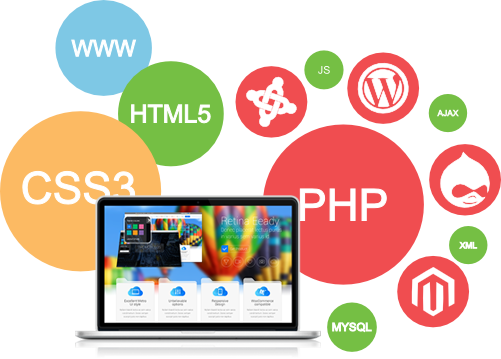
I want to giving you short informations on the server-side web pages, today. I will show examples later.


Web languages are used to developing Web pages and applications. They are classified according to the technology used and the environment in which the developed application works.
Markup and Style Language
These languages aren’t intended for direct application development. They are used to format more data. They are not exactly programming languages, but they themselves have certain rules for formatting the data in web pages in different ways.
Examples of markup languages are HTML, XHTML, DHTML, XML, JSON, etc. HTML (Hypertext Markup Language) and similar languages are the basic markup language for Web pages. Most of the code that is sent to the client of a Web page is encoded in the HTML language and displayed in the Web browser with a formal interpretation. The HTML5 version of the HTML language is widely used today. It is easy to read and write, by people. They also working in the data storage of Web applications without requiring any database management system. Apart from markup languages, it is used also use styled languages to format web pages. CSS is in this language class. CSS is used to format the visual appearance of HTML pages. CSS2 and CSS3 versions are widely used today. Like the CSS style language, the XSL style language used to format the appearance of XML data is rarely used in some applications.

Scripting Languages
Scripting languages are used to develop web applications. The code is divided into two parts, client-side and server-side.
1. Client-side scripting languages
Web applications written using these languages are interpreted and executed by the client. Examples of these languages are Javascript (JS), Postscript, VBScript, etc. Javascript has become the standard for client-side applications, nowadays. The source code for a Web page includes the HTML and CSS codes, as well as JS(Javascript) codes. There are also technologies that work on the client side and use less than JS. Adobe's Flash animation applications (Actionscript) and Microsoft's Silverlight applications are included in this class. High-level object-oriented written in the Java language, embedded into web pages, applications that require work in the Java virtual machine can also be considered as a client-side application.
2. Server-Side Scripting Languages
These languages are interpreted on the server side and the result is sent to the client. Languages such as ASP.NET, JSP, PHP, Python, Ruby are from this class. They are used for creating dynamic Web pages.
Server Based Web Programming
Web pages are divided into dynamic pages and static pages. The static page structure is usually used for informational pages. There is no interactive communication with the page visitor.
These pages can be likened to newspapers or magazines. The data (pages, pictures, tables, etc ...) that are on these pages can be seen. The data can not sent to page. A news can not be commented or voted on. There are 60% 80% HTML code and 20% 40% client-side code (Javascript, CSS) in the such pages. Static pages are little bit in cost of construction than dynamic pages. Updating or building changes are more difficult than dynamic pages, requiring high cost. Dynamic pages typically consist of server-side language extensions such as .asp, .php, .jsp. There is interactive communication with the page visitor. Various services can be offered to the page visitor. Site update can be done by the user (product: changing price lists, adding new files, preparing online brochures and sending thousands of customer emails with one touch ...). Web pages can be provided with services tailored to the company's goals. Company products can be sold through e-trade or the dealer network can be made online. Dynamic web pages come together to create web applications. However all of the code that makes up a web page may not be dynamic. Some of the page can be in static structure and some in dynamic structure. Such web pages are considered hybrids because they use static and dynamic technologies. Today, most of Web pages on the internet are static-dynamic(hybrid) structure.

What makes dynamic pages dynamic is that, content that returning to the client is changing depends on time and parameters. On these pages, you can send messages, vote up and send email.
Dynamic Web Page Working Steps
- The client computer (web browser) invokes a page from the web server via www.
- The web server checks to see if the request has static content, and if the content is static (html web page) it finds the page in the server's file system., and if the context is static (HTML Web page), it finds this page from the server's file system.
- If the request is made to a dynamic page, an interpreter on the server interprets this page, runs it, and retrieves the required output as an HTML web page.
- The server obtains the html web page obtained in step 2 or 3 via www send it back.
- Displays the static (HTML) Web page that came to it in the browser as result of a client request.

The static (HTML) Web page that comes here to the client can contain code-side scripting (JS) or CSS codes. The above steps are performed separately for each request made by the client.
Resources
[w3schools]
[webhostingtalk]
[phpbuilder]
[forum.wampserver]
[wiki/Session]
[helpx.adobe]
Html is a basic web language.
For Back-end programming you have To learn PHP.
There are lot of PHP frame works also which make work more easier.
Thanks for sharing nice info.
@qamarjaved
Thanks. You're right. I already know PHP.